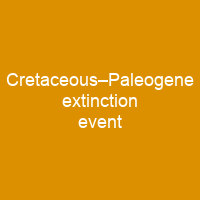The Cretaceous–Paleogene extinction event, 66 million years ago, was a sudden mass extinction of three-quarters of the plant and animal species on Earth. With the exception of some ectothermic species such as the sea turtles and crocodilians, no tetrapods weighing more than 25 kilograms survived. The surviving group of dinosaurs were avians, ground and water fowl who radiated into all modern species of bird.
About Cretaceous–Paleogene extinction event in brief

In October 2019, researchers reported that the event rapidly acidified the oceans, producing ecological collapse and, in this way as well, produced long-lasting effects on the climate, and accordingly was a key reason for the end-Cretaceous mass extinction. The best-known species perished in the K-Pg extinction, the best- known being the non-Avian dinosaurs. But the extinction also provided evolutionary opportunities: In its wake, many groups underwent remarkable adaptive radiation — sudden and prolific divergence into new forms and species within the disrupted and emptied ecological niches, such as horses, whales, bats, and primates. In January 2020, scientists reported new evidence that the extinctionEvent was mostly a result of the meteorite impact and not volcanism. The fact that the extinctions occurred simultaneously provides strong evidence that they were caused by an asteroid. A 2016 drilling project into the Chicxulub peak ring confirmed that the peak ring comprised granite ejected within minutes from deep in the earth, but contained hardly any gypsum, the usual sulfate-containing sea floor rock in the region. The gypsums would have vaporized and dispersed as an aerosol into the atmosphere, causing longer-term effects on climate and food chain. In the oceans,. the extinction killed off plesiosaurs and mosasaurs and devastated teleost fish, sharks, mollusks, and many species of plankton.
You want to know more about Cretaceous–Paleogene extinction event?
This page is based on the article Cretaceous–Paleogene extinction event published in Wikipedia (as of Nov. 30, 2020) and was automatically summarized using artificial intelligence.







